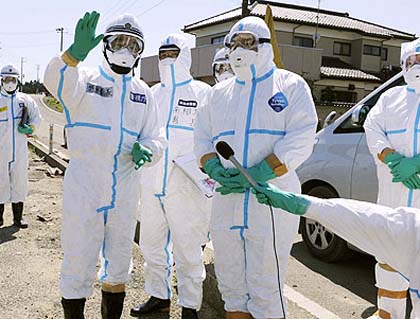TOKYO – The operator of Japan's crippled nuclear plant began pumping highly radioactive water from the basement of one of its buildings to a makeshift storage area Tuesday in a crucial step toward easing the nuclear crisis. Removing the 25,000 metric tons (about 6.6 million gallons) of contaminated water that has collected in the basement of a turbine building at Unit 2 of the Fukushima Dai-ichi plant will help allow access for workers trying to restore vital cooling systems that were knocked out in the March 11 tsunami. It is but one of many steps in a lengthy process to resolve the crisis. Tokyo Electric Power Co. projected in a road map released over the weekend that it would take up to nine months to reach a cold shutdown of the plant. But government officials acknowledge that setbacks could slow the timeline.
The water will be removed in stages, with the first third of it to be handled over the coming 20 days, said Hidehiko Nishiyama of Japan's Nuclear and Industrial Safety Agency. In all, there are 70,000 tons (about 18.5 million gallons) of contaminated water to be removed from the plant's reactor and turbine buildings and nearby trenches, and the entire process could take months. TEPCO is bringing the water to a storage building that was flooded during the tsunami with lightly contaminated water that was later pumped into the ocean to make room for the highly contaminated water.
The operator plans to use technology developed by French nuclear engineering giant Areva to reduce radioactivity and remove salt from the contaminated water so that it can be reused to cool the plant's reactors, Nishiyama said, adding that this process would take "several months." Once the contaminated water in the plant buildings is safely removed and radioactivity levels decline, workers can begin repairing the cooling systems for the reactors of Units 1, 2 and 3, which were in operation at the time of the tsunami. Workers must also restore cooling functions at the plant's six spent fuel pools and a joint pool for all six units.
When the tsunami struck, units 5 and 6 were going through a regular inspection. On March 20, they were put in cold shutdown, which is when a reactor's core is stable at temperatures below 212 Fahrenheit (100 Celsius). With the nuclear crisis dragging on, public frustration with the government is growing. Opinion polls show more than two-thirds of Japanese are unhappy with the leadership of Prime Minister Naoto Kan, who was grilled for hours Monday by opposition politicians, many demanding he resign. TEPCO has offered residents forced to evacuate from homes around the plant about $12,000 per household as interim compensation. People elsewhere in the disaster zone who lost houses to the tsunami — which also left more than 27,000 dead or missing — say help has been slow to materialize.
"I don't understand what the politicians are doing, there are new committees and meetings everyday," said Hiroshi Sato, who lost his house in Kesennuma and now lives in a fabric warehouse from his old business. "We need support, financial assistance, and nothing has come yet," he said. In TEPCO's blueprint for stabilizing the reactors, the utility aims to cool the reactors and spent fuel pools and reduce radiation leaks over the next three months. Within 6-9 months, the goal is achieve a cold shutdown of the reactors and cover the buildings, possibly with a form of industrial cloth, to further tamp deter any possible radiation leaks.
Two remote-controlled robots sent into the reactor buildings of Unit 1 and Unit 3 on Sunday showed that radiation levels inside — up to 57 millisieverts per hour — were still too high for humans to realistically enter. The U.S.-made Packbots, which resemble drafting lamps on tank-like treads, also were briefly sent into Unit 2 on Monday, officials said, and the radiation level was found to be a much lower 4.1 millisieverts per hour.
But the high level of humidity inside the reactor building fogged up the robot's camera lens, making it difficult to see conditions inside. They were pulled out after less than an hour, officials said. "We didn't want to lose sight of where the robot was and then not be able to retrieve it," TEPCO manager Hikaru Kuroda said. The reason for the higher humidity wasn't clear, but it suggests that workers — if they were to go inside — also would have difficulty seeing through their masks, Kuroda said. (AP)

